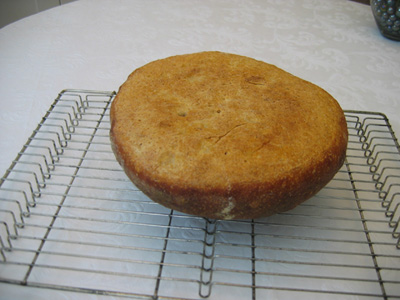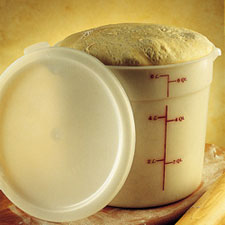I've been away for a short while developing starters using the technique posted by Debra Wink. I now have two starters that are 7 days old today, one all rye and one that I started with rye until it became active that I now refresh with white KA AP flour. Both are refreshed at 2:1:1 (starter:water:flour)
In an attempt to reduce waste, and also because I'm anxious, I took yesterday's "discard" and mixed it 60g:60g:60g. I placed it in a mason jar and waited for it to double, which took two hours. I searched here for a "simple" recipe and happened upon the 1-2-3 recipe. So, to my 180g starter I added 360g water, then 540g flour (10%Rye, 90%KA Bread) I stirred this together and let rest for 30 minutes, at which point it was STICKY. I did the slap and fold about five times and felt resistance from the dough, which seemed to want to tear, so I put it in an oiled bowl to rest.
I came back an hour later to no rise at all. The dough was still REALLY sticky, so I folded in the bowl and walked away. Two hours later, REALLY sticky, folded again. All this time there seemed to be no rise at all. After about six hours, the dough seemed to be about 150% its original volume, though I'm not sure how you can reliably tell. I shaped a boule, which I placed into a canvas lined colander to rest before putting into the fridge for the night.
In the morning, I took the dough out and placed it on parchment on the back of a baking sheet. After two hours it felt dense to me, and was still noticeably cold. When pressed gently with a finger, the indentation was slow to return, giving me concern that I would overproof. I turned the oven to 490F and preheated for a full hour. I slashed just prior to baking, but I don't think it was deep enough. I placed the loaf into the oven, reduced the temp to 450F, added water to the oven, and put a foil baking tray over the loaf for the first ten minutes. I then removed the baking tray and the steam pan to finish the bake.
I got very little oven spring, which I am guessing is a combination of under/over-proofing and scoring? Does it mean I over-proofed, didn't score deeply enough? How, if at all, does the amount of time spent bulk fermenting affect rise, and can that period also be too long or too short?
I liked the color of the top of the loaf, but the bottom was very pale in comparison, even with a full hour of pre-heat time. I have noticed this on my last three bakes. I'm guessing I need to pre-heat the stone even longer?? Hmmm, maybe this affected my oven spring as well?
The crust is soft, so I'm not sure if the foil tray over the baking loaf gave me the crispness I desire. Maybe a longer time next time? I left the loaf in the oven after it was done for an extra ten minutes with the door propped open.
All in all, I'm pleased with the effort. It seems my starter is capable of rising dough, though I have a great deal to learn in pretty much all respects. Looking forward to comments and suggestions. As always, thanks.


Unappealing bottom!

Crumb.
- MikeC's Blog
- Log in or register to post comments
Double-check the element in the bottom of your oven. Is it working?
Your crumb looks great, but moist, and the soft crust just supports that. Depending on your flour absorption, you could try cutting back on the water a little. But check out that heating element right away.
Susan from San Diego
As a non-sourdougher (yet) I think it looks great. Crumb looks wonderful. The important question of course is: How did it taste? Great first shot, please keep us up to date as you experiment and learn more.
Mike - that crumb looks GREAT, I don't think you had any problems at all except the browning on the bottom of the loaf. How did it taste? I am surprised that a week-old starter gave you as open a crumb as you have, you did a good job. Especially as that is a large-sized boule at 1 kilo of dough, it is hard to get a really open crumb with large holes when the loaf itself is large (i.e. small crust to crumb ratio). It looks like you guessed correct on both the bulk ferment times and the final proofing time. Your crust is nicely carmelized and blistered from the cold retarding.
Regarding the softer crust than you would like, it sounds like you did everything as I would have done it. As Susan says, something is definitely wrong with either the bottom oven element, or you have the stone on too high of a rack, because you certainly preheated long enough (I usually only preheat 45 min.). Did you take the internal loaf temp with a digital probe thermometer? I don't turn the oven off until the temp is closer to 205F in the center and then let it sit in the oven and crisp up another 6-10 min. My guess is that if you solve the undercooked bottom issue, your crust will also come out more crisp.
Also, during the bulk ferment, an easy way to tell how much it has risen is to use a straight-sided plastic lidded food storage container (see pic below) that you can mark the level of the dough when you first place it in there after the autolyse and initial kneading or folding. (They sell the yellow-lidded restaurant ones at Sam's in Kingston BTW, and also similar ones at KA Flour's Baker's catalog).
Susan, my oven is gas, and therefore only heats from the bottom when set to "bake" which I know it was, but that was a great thought.
MD, the stone was sitting on the lowest available shelf, at roughly 2.25 inches above the floor. The loaf was removed from the oven at 204 degrees. I'm reluctant to preheat my stone for 90 minutes, but it seems like the thing to do. Anyone else using the stone from KA Flour? Also, I like the rising bucket, but don't belong to Sam's.
The taste is very mildly sour, with just a hint of rye, and was perfect with a little teawurst, whole grain mustard and slivered onions for lunch today.
Huh...that is weird...you did put the loaf directly on the stone to bake and not on a sheet pan on the stone, correct? I'm not sure what the KA stone is like but I would think it should be fine given the source. (I actually use a $3 piece of 1/2 in thick natural bluestone from a local stoneyard, it's worked great for over 2 years.)
Didn't think about gas ovens!!! Okay, why don't you try preheating for say 30 minutes and don't use the stone. Use a heavy pizza pan or cookie sheet instead and preheat it along with the oven. Something's getting in the way of your heat if the bottom of your loaf is not brown. One last stray thought: Do you have a separate thermometer to check against the oven temp?
Use any straight-sided tub or canister to ferment your dough, and mark the height with masking tape. Where there's a will, there's a way.
MD gives great advice!
Susan from San Diego
Bluestone would have been a nicely affordable alternative. Actually, the loaf was on parchment which I slid onto the stone, as I don't have a peel. I'm wondering if I put the loaf in the oven too soon after it's overnight retardation in the fridge?
I have a taylor bulb type oven thermometer in the oven. My first loaves (before the stone) were baked in a half sheet pan, resulting in slightly lighter bottom crust, but nowhere as pronounced as this.
Mike, welcome to sourdough! As you have probably guessed by now, there is a learning curve to this ;-) It sounds like you have a healthy starter, but it wasn't ripe when you mixed your dough. I suspect that's why things didn't seem to progress during your bulk fermentation.
Especially with yeasted doughs, we get used to using 'double' as the guage of readiness. But that doesn't apply to starters. Yours doubled in only two hours, so it sounds nice and vigorous, but it isn't ready until it peaks and gets bubbly and uneven on the top. That should be at least triple volume, which will take 4-8 hours. The yeast count will be much higher and I'll bet everything else will move along better for you.
All things considered, this looks pretty darn good for a first try. -dw
First Debra, let me take this opportunity to thank you for the clear, detailed instructions on how to make a proper starter. I greatly appreciate as well the explanations of the inner workings, I found them helpful and they encouraged me to give it a try. I followed your plan to the letter, and it worked exactly as you said it would.
Now, if I understand what you are saying here, after I feed my starter at the desired rate to yield the quantity I need for a recipe (with enough left over) I should wait until it reaches its highest level, and how do I know what that is? Is it ok if it goes just past peak and starts to fall?
Finally, thanks again, to you and all the other TFL'ers whose informative posts have provided the technical insights and inspiration.
And thank you. I'm so glad it went smoothly for you. I think you are going to enjoy working with sourdough. At this point though, I recommend that you increase your refreshment rate for maintaining your starter. 2:1:1 is perfect up until the yeast start growing, and then it's better to increase the feeding to something more like 1:2:2 at least once a day (and twice wouldn't hurt). Sometimes I go to 1:1:1 3x a day or as often as it peaks. This will build vigor and rising power. It takes about two weeks for a new starter to improve and equilibrate. At that point, I will have to turn you over to the cookbooks and sourdough experts here who can better advise you in maintaining different types of starters and making good bread.
In the meantime, bake with it as often as you like, and get to know your starter. You will learn how high it can rise just by feeding and observing. Pay attention to what the surface looks like just before it starts to fall. Maybe even keep track on paper how long it takes to peak at different refreshment rates (so you can adjust when your schedule requires it). It may even stay at the peak for a while. When it just begins to fall is when it is ready to be mixed into bread dough, generally speaking. Sometimes a formula/recipe will specify what it should look like and how long it will take. Also make it a habit to read the temperature of the dough after mixing---that will have a big influence on how fast the dough is going to rise.